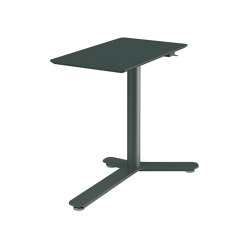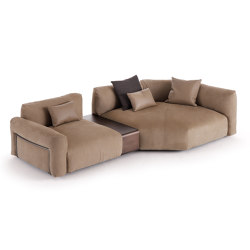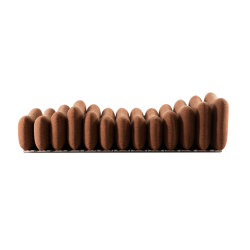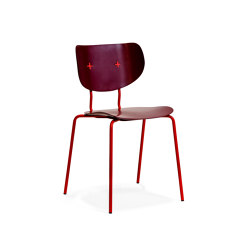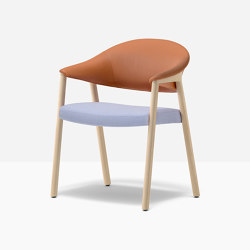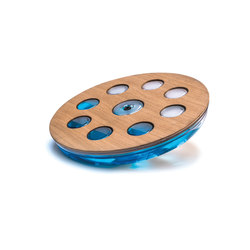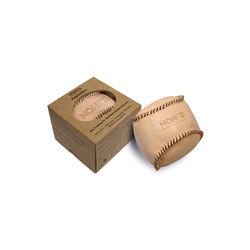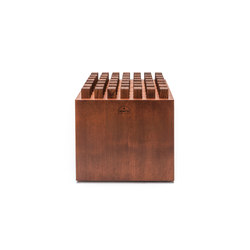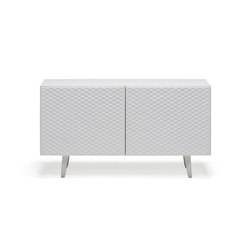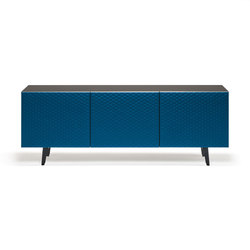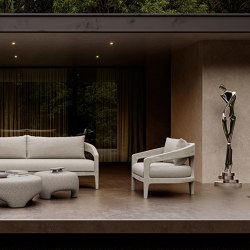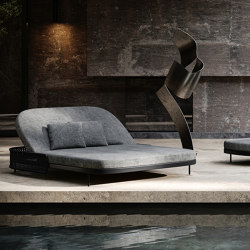Sobre HKT-Korhonen Oy
DESCUBRE MáS SOBRE HKT-KORHONEN OY
The furniture factory Korhonen was established in 1910, when along with three other carpenters, Otto Korhonen bought the Carpenters Co-operative Society, which operated at Uudenmaankatu 7 Turku. The products manufactured in the factory were quite diverse right from the beginning, consisting of doors, windows and furniture designed according to the style of that age.
The end of 1920 united the two visionaries of Finnish furniture designing, Otto Korhonen and Alvar Aalto. Aalto participated in two architectural competitions in the 1920's, the designing and planning of Maalaistentalo (Countrymen's House) in South West Finland and the Paimio sanatorium, and won them both. Hundreds of individual pieces of furniture were needed. During 1929-1933 their collaboration yielded a collection of armchairs, a circular table and different tables to the patient rooms and staff facilities.
Alvar Aalto and Otto Korhonen created, in co-operation the base to all activity in Furniture Factory Korhonen for the coming decades. Even today about 75 percent of Korhonen's overall production consists of Aalto- Furniture.
The decade between 1940-50 was an important period for developing the manufacturing process. The growing demand for Aalto furniture was to be supplied by Korhonen. The new revolutionary wood bending method, developed in the 1930's, produced the basic elements of the famous Aalto design and look; the bent foot from solid birch, the flexible wooden chair, and a stackable row chair. In 1947 Aalto developed his famous 'Y' foot. His next creation, 'X' foot, Aalto created in 1954.
The world conquest of the Aalto furniture started already in the beginning of 1930. After the war, an era of new development begun: quality designs were now also desired to decorate ordinary homes. Artek Oy was established in 1935, and is still in charge of marketing. There were plenty of domestic orders in the late 1940s, although the final destination was sometimes found abroad, like the Finnish Embassy in London and the Finland House in New York. The export side of the business started its revival in the 1950s. The demand for larger table and chair production volumes grew, and the old factory in Nummenmäki proved unsatisfactory and too primitive for the growing needs. A preferable site was finally found in Littoinen near Turku. The gradual transition of production began in 1965. In 1972, more than half of the workers were already in place in Littoinen. In 1975, with somewhat nostalgic feelings the old Nummenmäki premises were abandoned altogether.
Some of the largest projects in the 1970s included the furnishing of Finlandia House and the head office of KELA (National Pensions Institute). Korhonen furnished all 3 000 residential rooms of Turku Student Village, as well as the restaurants, recreation and meeting facilities through seven separate building stages. In addition, other important public premises such as churches, libraries, schools and day care centres were furnished.
The continuity of the production for over 90 years is based on the succesful combination of high quality tradition of handicraft and technology. The automation of the production in early 1980s gave a new dimension to the production of Aalto furniture. The growing demand could now be tackled with greater accuracy. Furthermore, the automation of surface treatment enables finishing furniture with higher speed and precision. CNC -controlled machinery combine the different and complex phases to an efficient entirety.
In 1990s came other design products to accompany the Aalto range. Interior architect Rauno Sorsa designed the Raami-Frame® collection, the only furniture collection in 1997 to be awarded the Pro Finnish Design competition with a commendation. Korhonen has also developed several new collections with top Finnish designers. The popularity of the Frame collection helped launch several new products, such as the Vera collection, and the Object collection. These designs have roused interest abroad: the ever trendy Wallpaper magazine has published several articles concerning the Vera chair. Other new products made by Korhonen interior designer Timo Saarnio's collection. Subcontracting has also provided the needed stability. The right materials, new technology and enviromental consciousness lead us towards a bright 21st century.
Korhonen has been working on its new designs with patience, never sacrifying quality. The new items will all be creations of a long research and development process, highly capable and high quality design furniture. Following Otto Korhonen and Alvar Aalto´s footsteps in experimenting and innovating, Korhonen Oy celebrated it ninetieth anniversary by assembling a workshop of young talented designers.
Today Korhonen Oy has one hundred employees working in Littoinen, Kaarina. Together with an able staff and skillfully made high quality designs we have succesfully travelled through the many decades. Although time, place, technology and the terms have undergone sometimes dramatic changes, the traditional basics are still nourished and preserved with honour.
The furniture factory Korhonen was established in 1910, when along with three other carpenters, Otto Korhonen bought the Carpenters Co-operative Society, which operated at Uudenmaankatu 7 Turku. The products manufactured in the factory were quite diverse right from the beginning, consisting of doors, windows and furniture designed according to the style of that age.
The end of 1920 united the two visionaries of Finnish furniture designing, Otto Korhonen and Alvar Aalto. Aalto participated in two architectural competitions in the 1920's, the designing and planning of Maalaistentalo (Countrymen's House) in South West Finland and the Paimio sanatorium, and won them both. Hundreds of individual pieces of furniture were needed. During 1929-1933 their collaboration yielded a collection of armchairs, a circular table and different tables to the patient rooms and staff facilities.
Alvar Aalto and Otto Korhonen created, in co-operation the base to all activity in Furniture Factory Korhonen for the coming decades. Even today about 75 percent of Korhonen's overall production consists of Aalto- Furniture.
The decade between 1940-50 was an important period for developing the manufacturing process. The growing demand for Aalto furniture was to be supplied by Korhonen. The new revolutionary wood bending method, developed in the 1930's, produced the basic elements of the famous Aalto design and look; the bent foot from solid birch, the flexible wooden chair, and a stackable row chair. In 1947 Aalto developed his famous 'Y' foot. His next creation, 'X' foot, Aalto created in 1954.
The world conquest of the Aalto furniture started already in the beginning of 1930. After the war, an era of new development begun: quality designs were now also desired to decorate ordinary homes. Artek Oy was established in 1935, and is still in charge of marketing. There were plenty of domestic orders in the late 1940s, although the final destination was sometimes found abroad, like the Finnish Embassy in London and the Finland House in New York. The export side of the business started its revival in the 1950s. The demand for larger table and chair production volumes grew, and the old factory in Nummenmäki proved unsatisfactory and too primitive for the growing needs. A preferable site was finally found in Littoinen near Turku. The gradual transition of production began in 1965. In 1972, more than half of the workers were already in place in Littoinen. In 1975, with somewhat nostalgic feelings the old Nummenmäki premises were abandoned altogether.
Some of the largest projects in the 1970s included the furnishing of Finlandia House and the head office of KELA (National Pensions Institute). Korhonen furnished all 3 000 residential rooms of Turku Student Village, as well as the restaurants, recreation and meeting facilities through seven separate building stages. In addition, other important public premises such as churches, libraries, schools and day care centres were furnished.
The continuity of the production for over 90 years is based on the succesful combination of high quality tradition of handicraft and technology. The automation of the production in early 1980s gave a new dimension to the production of Aalto furniture. The growing demand could now be tackled with greater accuracy. Furthermore, the automation of surface treatment enables finishing furniture with higher speed and precision. CNC -controlled machinery combine the different and complex phases to an efficient entirety.
In 1990s came other design products to accompany the Aalto range. Interior architect Rauno Sorsa designed the Raami-Frame® collection, the only furniture collection in 1997 to be awarded the Pro Finnish Design competition with a commendation. Korhonen has also developed several new collections with top Finnish designers. The popularity of the Frame collection helped launch several new products, such as the Vera collection, and the Object collection. These designs have roused interest abroad: the ever trendy Wallpaper magazine has published several articles concerning the Vera chair. Other new products made by Korhonen interior designer Timo Saarnio's collection. Subcontracting has also provided the needed stability. The right materials, new technology and enviromental consciousness lead us towards a bright 21st century.
Korhonen has been working on its new designs with patience, never sacrifying quality. The new items will all be creations of a long research and development process, highly capable and high quality design furniture. Following Otto Korhonen and Alvar Aalto´s footsteps in experimenting and innovating, Korhonen Oy celebrated it ninetieth anniversary by assembling a workshop of young talented designers.
Today Korhonen Oy has one hundred employees working in Littoinen, Kaarina. Together with an able staff and skillfully made high quality designs we have succesfully travelled through the many decades. Although time, place, technology and the terms have undergone sometimes dramatic changes, the traditional basics are still nourished and preserved with honour.
DESCUBRE MáS SOBRE HKT-KORHONEN OY
